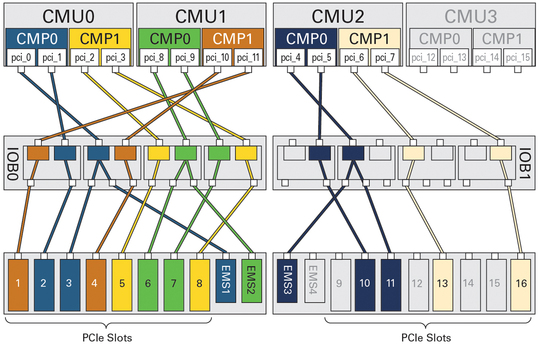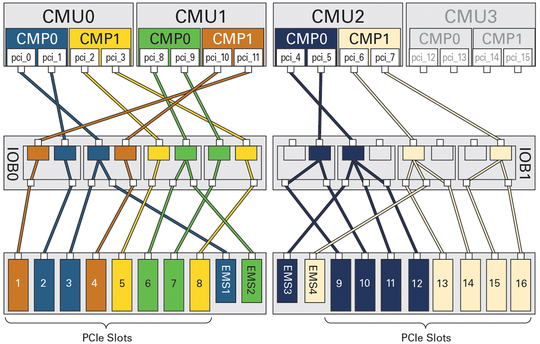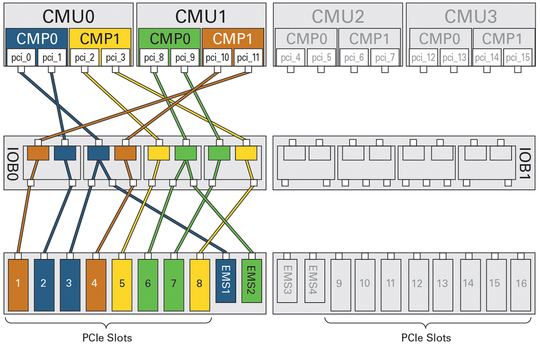| Skip Navigation Links | |
| Exit Print View | |

|
SPARC M5-32 and SPARC M6-32 Servers Administration Guide |
Understanding the System Architecture
Understanding PCIe Device Root Complexes
Control Domain and Reserved Root Complexes
Fully-Populated Default Configuration
Understanding PCIe Slot Root Complex Names and Device Paths
Understanding DCU0 Root Complex Names and Device Paths
DCU0 PCIe and EMS Slot Locations
Fully-Populated DCU0 PCIe Slot Root Complexes
Half-Populated DCU0 PCIe Slot Root Complexes
Understanding DCU1 Root Complex Names and Device Paths
DCU1 PCIe and EMS Slot Locations
Fully-Populated DCU1 PCIe Slot Root Complexes
Half-Populated DCU1 PCIe Slot Root Complexes
Understanding DCU2 Root Complexes and Device Paths
DCU2 PCIe and EMS Slot Locations
Fully-Populated DCU2 PCIe Slot Root Complexes
Half-Populated DCU2 PCIe Slot Root Complexes
Understanding DCU3 Root Complexes and Device Paths
DCU3 PCIe and EMS Slot Locations
Fully-Populated DCU3 PCIe Slot Root Complexes
Half-Populated DCU3 PCIe Slot Root Complexes
Understanding EMS SAS Paths to the Internal Drives
SAS Paths From EMS Module to Drives
Understanding Internal Drive Device Paths
HDD and SSD Device Path Differences
Understanding DCU0 Drive Device Paths
Understanding DCU1 Drive Device Paths
Understanding DCU2 Drive Device Paths
Understanding DCU3 Drive Device Paths
Understanding Network Port Device Paths
DCU0 Network Port Device Paths
DCU1 Network Port Device Paths
DCU2 Network Port Device Paths
DCU3 Network Port Device Paths
Understanding Configuration Guidelines
Understanding System Administration Resources
Understanding Platform-Specific Oracle ILOM Features
SPARC: Server-Specific and New Oracle ILOM Features and Requirements
Unsupported Oracle OS Features
Unsupported Oracle ILOM Features
Oracle VM Server for SPARC Overview
Multipathing Software Overview
Oracle ILOM Remote System Console Plus Overview
Oracle Hardware Management Pack Overview
Oracle Enterprise Manager Ops Center
Time Synchronization and NTP Service
Multi-Domain Extensions to ILOM MIBs
Establish a Network Management Connection to Oracle ILOM
Log In to Oracle ILOM (Web Interface)
Logging In to Oracle ILOM (CLI)
Switch Between the Oracle ILOM CLI and the System Console on a Host
Connect to a PDomain When the System Is Unconfigured and Powered Off
Connect to a PDomain When the Oracle Solaris OS Is Running
Connect to a PDomain When the Oracle Solaris OS Is Unresponsive
Get to the ok Prompt When the Host Is Powered On (Web Interface)
Connect to an LDoms Guest Domain
Connect to Oracle ILOM Remote System Console Plus
Enable Video Redirection From the Oracle Solaris OS
Configure Multiple Display Devices
Reestablish KVMS Connection to SPPs After a Reboot
Controlling the Server, Domains, and Devices
Resetting the Server, SP, or Domains
Reset the Server (Oracle Solaris)
Resetting the SP Configuration
Managing the Server's Boot Behavior
Change the Default Boot Device (ok Prompt)
Create an OpenBoot Boot Path to a Boot Disk
Enable or Disable Automatic Booting (ok Prompt)
SPARC: OpenBoot Boot Configuration Parameters
Booting and Shutting Down the OS
Manually Boot the OS (ok Prompt)
Configuring Oracle ILOM User Accounts and Roles
Understanding Platform and Host-Specific User Role Assignments
Configuring User Accounts (SNMP)
Configuring Host Groups to Authenticate User Accounts (CLI)
Configuring Host Groups to Authenticate User Accounts (SNMP)
Record Network Parameter Values
Viewing the Network Configuration
View Configuration Details for the Network
View Configuration Details for SPs and Hosts
Determine Which SP Is the Active SP
Change the Current Role of the SP Pair
Disable or Re-Enable Network Access to an SP or Host
Determine Current DCU Assignment
Migrate DCUs to a New PDomain (CLI)
Administering CMUs, CMPs, and DIMMs
Display Summary of Installed CMUs
Administering IOUs and PCIe Device Root Complexes
Manage I/O Path Reconfiguration Settings
Identify the Root Complex of a Device
Identifying Domain-Level Commands
PDomain Configuration and Monitoring Commands
Single Sign-On Service Network Deployment Commands
Dedicated SP Interconnect Property Commands
FMA Fault Proxying and Reserved Root Complexes
Virtual Keyswitch Property Commands
Locate the Server (Web Interface)
Obtain the Server Serial Number
Viewing Server and Component Information
Viewing System-Level Information
Viewing Individual Component Properties
XSCF and Oracle ILOM Command Comparison
Identifying SP Configuration and Administration Commands
User Account Administration Commands
Network Configuration/Administration Commands
Each PCIe and EMS slot can be associated to either a primary root complex or a secondary root complex, depending on the configuration of the DCU. When the DCU contains four healthy CMUs, all of the PCIe and EMS slots will be associated to their primary root complexes.
When a CMP or CMU fails, or when a CMU is removed, the primary root complexes on that CMP or CMU will no longer be available. Depending on how you set the Oracle ILOM ioreconfigure property on the PDomain host, the PCIe or EMS slots will either be rerouted to their secondary root complexes or the slots will no longer be available.
The ioreconfigure property signals under what conditions the PCIe I/O fabric paths from the root complexes to the slots will be created. After the server is powered on for the first time, the ioreconfigure property will be set to true. During the initial power on, the PCIe I/O fabric paths will be created for all of the PCIe and EMS slots in the server.
If you set the ioreconfigure property to false, the PCIe I/O fabric paths will not be recreated when a CMU or CMP fails or is removed. The PCIe and EMS slots routed to the primary root complexes on the missing CMU or CMP will no longer be available.
If you set the ioreconfigure property to true, the PCIe I/O fabric paths will be recreated when you next restart the PDomain. If the primary root complexes for PCIe or EMS slots are no longer available and you have set the ioreconfigure property to true, the PCIe I/O fabrics for these slots will be rerouted to their secondary root complexes and the virtual switches will be merged to function from a single root port.
In the following illustration, CMU3 has either failed or has been removed from DCU0. Since the ioreconfigure property is set to false, one EMS slot and four PCIe slots are no longer accessible.

The following illustration displays what happens when you set the ioreconfigure property to true. The PCIe and EMS slots that were once routed to the primary root complexes on CMU3 have been rerouted to their secondary root complexes on CMU2.
For example, PCIe slot 9 has been rerouted from its primary root complex, pci_15, to its secondary root complex, pci_5. The OpenBoot PROM device path for PCIe slot 9 has changed from the primary path on CMU3/CMP1 (pci@6c0):
/pci@6c0/pci@1/pci@0/pci@8
To the secondary path on CMU2/CMU0 (pci@440):
/pci@440/pci@1/pci@0/pci@8
Note - Any OpenBoot PROM variables that reference the original (pci@6c0) device path will no longer work, even though there is now an equivalent, secondary device path.

In the following illustration, DCU0 contains only CMU0 and CMU1. Since the primary and secondary root complexes on CMU2 and CMU3 are no longer available, you cannot access EMS slots 3 and 4 and PCIe slots 9 through 16.
When neither the primary nor secondary root complex of a PCIe or EMS slot is available, you cannot access the slot as there is no electrical path from a working root complex through the PCIe I/O switch fabric to the slot.
